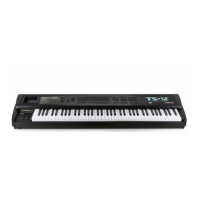TS-12 Musician’s Manual Section 7 — Effect Parameters
7
For a complete description of the remaining parameters, refer to the DDL+CHORUS+REV
algorithm found earlier in this section.
05 DISTORT+CHORUS+REV
This parallel effect combines a raspy distortion with a chorus and a reverb. The second sub-page
(not user-programmable) shows how this parallel effect is routed:
• Voices assigned to FX1 (and panned left) are sent to Effect A (DISTORT)
• Voices assigned to FX1 (and panned right) are sent to Effect B (CHORUS)
• Voices assigned to FX2 are sent to the reverb (REV)
For a complete description of the SENDS parameters, refer to the DDL+CHORUS+REV algorithm
found earlier in this section.
DIST MIX Range: 00 to 99
Controls the mix between the original signal and the distortion. Setting this parameter to 00 will
allow only the unprocessed signal to be heard, while a setting of 99 will eliminate it completely,
with only the distortion portion remaining.
LEVEL Range: 00 to 99
Controls the input level to the pre-amp, to eliminate the possibility of clipping boosted signals.
PAN Range: -99 to +99
Determines the location of the distortion in the stereo spectrum. A value of -99 is panned hard
left, and +99 is hard right.
PREAMP Range: 00 to 99
Adjusts the amount of boost or cut applied to the incoming signal. We recommend lower
settings, since these emulations were optimized for distortion there. Lower preamp gains will
result in less distortion, while higher preamp gains will yield clipping distortion. For low
preamp gain, it may be desirable to use low tube bias values.
MAIN Range: 00 to 99
Controls the output level of the main amp after saturation, but before the filter.
BIAS Range: -99 to +99
Controls the emphasis of even to odd harmonics which determines the tone of the amp; mid
values emphasize even harmonics and offer a warmer (“glowing tube”) sound, while the highest
values may sound like tubes going bad. For low preamp gain, it may be desirable to use low tube
bias values, because this more closely imitates the operation of a real amplifier.
TONE Range: 0000 to 8000
Controls the cutoff frequency. This is much like a tone control on a guitar amp. By applying a
real-time controller to modulate this parameter, you can create a wah-pedal effect.
RESONANCE Range: 00 to 99
Controls the bandwidth of the filter. Higher settings yield a narrower bandwidth.
For a complete description of the remaining parameters, refer to the DDL+CHORUS+REV
algorithm found earlier in this section.

